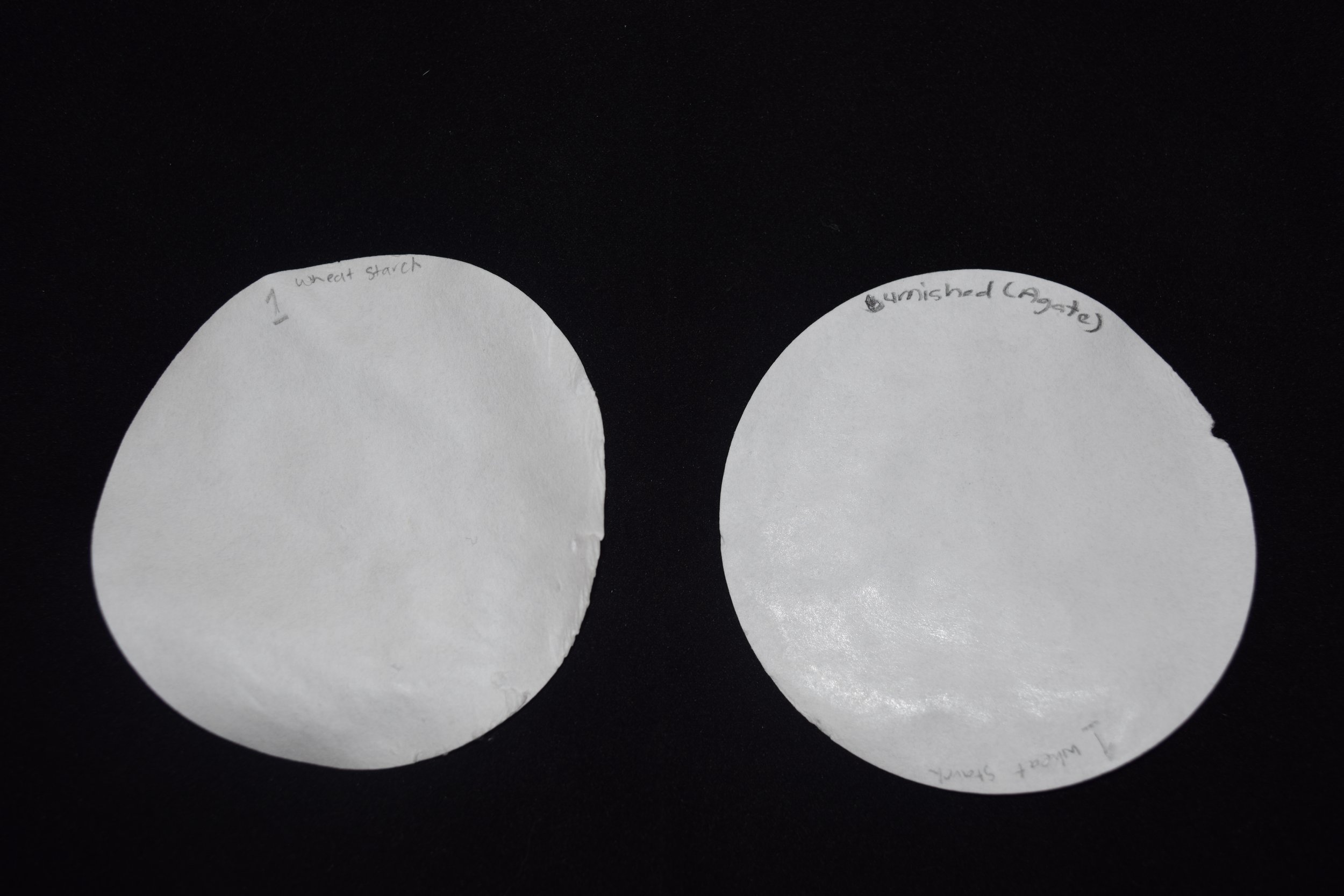WHEAT STARCH (NEŠĀSTE GANDOM)
Wheat starch, when dried, forms a strong bond and has historically been used as a paper sizing agent. It continues to serve as a primary adhesive for conservators, especially for tasks such as hinging, mending, lining, and reinforcement.
Recipes:
In detailed recipes found in "Ḵaṭṭ va Morakkab" by Hossein Aqili Rostamdari (978 A.H./1571 A.D.) and "Golzār-e Ṣafā" by Ali Seyrafi (950 A.H./1543 A.D.), wheat is highlighted. Hossein Aqili Rostamdari emphasizes the importance of applying sizing on paper with a cotton ball. He further recommends using a moist cotton ball afterward to smoothen the sized surface.
در بیان آهار کردن
چون خواهد که کاغذ را آهار کنند باید که اول شیره گندم بگیرند وصاف کنند و بعد از آن بپزند. وچون آهار پخته شد تخته بیاورند و بر بالای آن تخته نمدی یا کرباسی بیندازند و آهار را در قدحی ریزند ویک قدحی دیگر آب در پیش هم بگذارند و بعد از آن اندکی آهار از پنبه بردارند و بر آن چیز مالند، بعد از آن پنبه دیگر از آب تر کنند فی الحال بر آن مالند و بیندازند
To size a piece of paper, take some wheat starch, filter it, and then cook it to make a paste. Then take a wooden board and cover it with felt (namad) or a muslin cloth. Take two bowls; pour the starch into one and some water into the other. Moisten a ball of cotton with starch and rub it over the paper. Finally, take another piece of clean cotton ball, moisten it with water, and rub it over the starched paper. The paper can be sized this way.
In Golzār-e Ṣafā, Seyrafi (950 A.H./1543 A.D.), describes the same process mentioned above beautifully in the form of a poem:
صفت آهار نشاسته
ای مرا دیده و دل سوی تو باز طلبم ناز تو هر دم به نیاز
حال آهار که وافی باشد شیره گندم صافی باشد
طبخ کن شیره گندم بسیار پس بپالای و ببر باز بکار
چونکه آهار کنی ای مهوش بشنو از من صفت آن دلکش
تختهای پیش نه از روی قیاس نمد افکن به سرش یا کرباس
قدحی پر کن از آهار دگر قدحی آب همان پیشآور
جز وی آهار به پنبه بردار کاغذ ای سرو روان ده آهار
تر کن از آب دیگر پنبه پاک پس به آهار بمالش چالاک
که همان مصلح آهار شوی صفحه زین قاعده هموار شوی
Attributes of Different Sizings
Oh, my dear, my eyes and ears to you incline,
For your grace, my heart does forever pine.
The perfect size, a wheat extract so fine,
Boil it, filter it, repeat, a practice divine.
As you size the paper, oh moon-faced delight,
Hear the heartwarming attributes I recite.
Place boards measured true, cover them right,
With felt or muslin, in precision’s light.
Fill a bowl with sizing, to the brim it climbs,
Another with water, ready for these rhymes.
Take sizing on cotton, a graceful act,
Apply it to paper, that’s the crafting pact.
Wet cotton piece, clean and neat,
Rub it on the paper, see the surface greet.
A restorer of sizing, you become in this line,
The page now smooth, with a charm so fine.
Now, with a moist cotton ball, ever so slight,
Rub it once more, ensure the surface is bright.
Experiments:
To start, pour 100ml of cold water into a glass jar with a 25g wheat starch ratio of 1:4. Cover and soak the starch at room temperature for an hour. Transfer the mixture to a saucepan and cook over moderate heat, continually stirring. Meanwhile, heat 150ml of water in another saucepan, and just before it starts boiling, pour it slowly into the saucepan with the starch/water mixture, stirring the paste vigorously. Adding pre-heated water hastens the cooking process. More hot water can be added to reach the desired thickness. Cook for 35 minutes, stirring constantly with a wooden stick until obtaining a smooth paste. Remove the paste from the heat and let it cool.
Then, take a wooden board and cover it with a muslin cloth. Take two bowls; pour the wheat starch into one and some water into the other. In the traditional way, moisten the paper first with a ball and of cotton with starch and rub it over the paper. Finally, take another piece of a clean cotton ball, moisten it with water, and rub it over the wheat-starched paper to smoothen it. Instead of the traditional way using a cotton ball, you can use a soft brush in this process as well. Then burnish the paper to achieve a smooth surface after the paper is dried.







